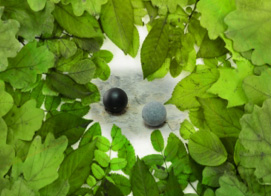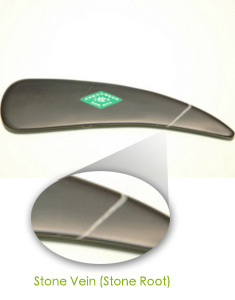How does it work?
 The Nature of Bianstone and Its Therapeutic Mechanism
Bianstone is a kind of stone with a Therapeutic function. To understand why this kind of rare stone is capable of curing diseases, it is necessary that we investigate its structure and its therapeutic mechanism from a scientific point of view.
The Nature of Bianstone and Its Therapeutic Mechanism
Bianstone is a kind of stone with a Therapeutic function. To understand why this kind of rare stone is capable of curing diseases, it is necessary that we investigate its structure and its therapeutic mechanism from a scientific point of view.
Chemical Structure 5,6,7,11,12
Bianstone, which is a family member of carbonate stone, (i.e. limestone), is characterized by an exquisite texture, closely arranged spars and a low level of impurities.
Bianstone is a family member of carbonate stone, (i.e. limestone), which consists of 95% of dense crystalline calcite with a diameter of 0.03μm (i.e. CaCO3), a small amount of pyrite (with a diameter of less than 0.03μm) and clay. 5,6,11 Owing to the presence of a tiny amount of pyrite, the original stone section of Bianstone generally displays a color of dark gray and slight yellow while polished Bianstone appears dark. Bianstone is characterized by an exquisite texture, closely arranged spars and a low level of impurities.
Stone Vein and Texture 5,6
 stone veins are formed when the meteorite crashes into the ground, flinging debris into the air, it has become an important criterion in authenticity test and formation analysis.
Stone vein, also called stone root, is formed in the scissors-shaped micro-faults of different geological periods, assuming a conjugation or an echelon shape. Apart from the scissors-shape micro-faults, there is also a group of one-off micro-fault. And some Bianstone products possess veins caused by fault. Since stone veins are formed when the meteorite crashes into the ground, flinging debris into the air, it has become an important criterion in authenticity test and formation analysis.
stone veins are formed when the meteorite crashes into the ground, flinging debris into the air, it has become an important criterion in authenticity test and formation analysis.
Stone vein, also called stone root, is formed in the scissors-shaped micro-faults of different geological periods, assuming a conjugation or an echelon shape. Apart from the scissors-shape micro-faults, there is also a group of one-off micro-fault. And some Bianstone products possess veins caused by fault. Since stone veins are formed when the meteorite crashes into the ground, flinging debris into the air, it has become an important criterion in authenticity test and formation analysis.
 stone veins are formed when the meteorite crashes into the ground, flinging debris into the air, it has become an important criterion in authenticity test and formation analysis.
Stone vein, also called stone root, is formed in the scissors-shaped micro-faults of different geological periods, assuming a conjugation or an echelon shape. Apart from the scissors-shape micro-faults, there is also a group of one-off micro-fault. And some Bianstone products possess veins caused by fault. Since stone veins are formed when the meteorite crashes into the ground, flinging debris into the air, it has become an important criterion in authenticity test and formation analysis.
stone veins are formed when the meteorite crashes into the ground, flinging debris into the air, it has become an important criterion in authenticity test and formation analysis.
Stone vein, also called stone root, is formed in the scissors-shaped micro-faults of different geological periods, assuming a conjugation or an echelon shape. Apart from the scissors-shape micro-faults, there is also a group of one-off micro-fault. And some Bianstone products possess veins caused by fault. Since stone veins are formed when the meteorite crashes into the ground, flinging debris into the air, it has become an important criterion in authenticity test and formation analysis.
Radioactivity Test 5,6,11
The test results of Nuclear Research Center of Geological Analysis reveal that the internal exposure index within the radioactive specific activity of Bianstone is 0.043 and to the external exposure index is 0.044, far below the national safety standard. And the radioactivity of Bianstone is even much lower than that of the average stone building materials and ceramic tableware.
Measure of the Amount of Trace Elements (μg/g) 6,11
Trace elements analysis shows that there are more than thirty trace elements such as strontium (Sr)、thallium (Ti)、vanadium (V)、nickel (Ni)、manganese (Mn) and zinc (Zn) elements which are beneficial and necessary for human beings. more...
Note: Table lists out the amount of trace elements in Bianstone.
(*) Not Detected (Shown as grey in above table)
| 1 H |
2 He |
||||||||||||||||||
| 3 Li 0.301 |
4 Be 0.108 |
5 B |
6 C |
7 N |
8 O |
9 F |
10 Ne |
||||||||||||
| 11 Na |
12 Mg |
13 Al |
14 Si |
15 P |
16 S 0.012 |
17 Cl |
18 Ar |
||||||||||||
| 19 K |
20 Ca |
21 Sc 1.03 |
22 Ti 1186 |
23 V 11.0 |
24 Cr 3.65 |
25 Mn 41.9 |
26 Fe |
27 Co 1.41 |
28 Ni 11.8 |
29 Cu 4.14 |
30 Zn 4.89 |
31 Ga 0.620 |
32 Ge 0.464 |
33 As < 0.2 |
34 Se 0.077 |
35 Br |
36 Kr |
||
| 37 Rb 6.69 |
38 Sr 2165 |
39 Y 3.69 |
40 Zr 7.79 |
41 Nb 0.610 |
42 Mo 0.095 |
43 Tc |
44 Ru |
45 Rh |
46 Pd |
47 Ag |
48 Cd * |
49 In |
50 Sn * |
51 Sb * |
52 Te 0.049 |
53 I |
54 Xe |
||
| 55 Cs 0.347 |
56 Ba 40.9 |
71 Lu 0.037 |
72 Hf 0.217 |
73 Ta |
74 W 0.160 |
75 Re 0.002 |
76 Os |
77 Ir |
78 Pt |
79 Au |
80 Hg 0.01 |
81 Tl 0.015 |
82 Pb 1.25 |
83 Bi < 0.1 |
84 Po |
85 At |
86 Rn |
||
| 87 Fr |
88 Ra |
103 Lr |
104 Rf |
105 Db |
106 Sg |
107 Bh |
108 Hs |
109 Mt |
110 Ds |
111 Rg |
112 Cn |
113 Uut |
114 Uuq |
115 Uup |
116 Uuh |
117 Uus |
118 Uuo |
||
| 57 La 3.19 |
58 Ce 5.54 |
59 Pr 0.764 |
60 Nd 2.92 |
61 Pm |
62 Sm 0.596 |
63 Eu 0.121 |
64 Gd 0.598 |
65 Tb 0.083 |
66 Dy 0.434 |
67 Ho 0.094 |
68 Er 0.283 |
69 Tm 0.044 |
70 Yb 0.252 |
||||||
| 89 Ac |
90 Th 0.607 |
91 Pa |
92 U 1.06 |
93 Np |
94 Pu |
95 Am |
96 Cm |
97 Bk |
98 Cf |
99 Es |
100 Fm |
101 Md |
102 No |
||||||
(*) Not Detected (Shown as grey in above table)
Detection of Hazardous Substances 5
The amount of five hazardous substances (Pb, Cd, Cr, Hg & As) in Bianstone is much lower than the limit in the national safety standard and is suitable to use widely as raw materials in tools and accessories. more...
| Element | Lead (Pb) | Cadmium (Cd) | Chromium (Cr) | Mercury (Hg) | Arsenic (As) |
| GB 18584-2001Standard (μg/g) | ≦90 | ≦75 | ≦60 | ≦60 | No provision |
| GB 7916-1987 Standard(μg/g) | ≦40 | No provision | No provision | ≦1 | ≦10 |
| GWJ 001-2005 Standard(μg/g) | ≦20 | ≦35 | ≦30 | ≦0.5 | ≦5 |
| Hazardous Chemicals measured value(μg/g) | 1.25 | No provision | 3.65 | 0.01 | 0.2 |
 I am 74 years old. Long-term suffering of vascular and bone problems have been my scourge of old ages of years. My back and neck pain always alert me that I grow old. I always ask myself: What else can I do when I am down there when I squat down to tie up your loose shoe laces? I am too painful and I am that old. Few months ago, one of my friends who had been to China and told me something about a miracle stone - Bianstone in China that are very good for curing vascular and bone disease. Seeking this stone as my last resort , I asked her to buy some for me ,now after I using it, the miracle are really happened to me ,all my symptom are disappeared !
I am 74 years old. Long-term suffering of vascular and bone problems have been my scourge of old ages of years. My back and neck pain always alert me that I grow old. I always ask myself: What else can I do when I am down there when I squat down to tie up your loose shoe laces? I am too painful and I am that old. Few months ago, one of my friends who had been to China and told me something about a miracle stone - Bianstone in China that are very good for curing vascular and bone disease. Seeking this stone as my last resort , I asked her to buy some for me ,now after I using it, the miracle are really happened to me ,all my symptom are disappeared !